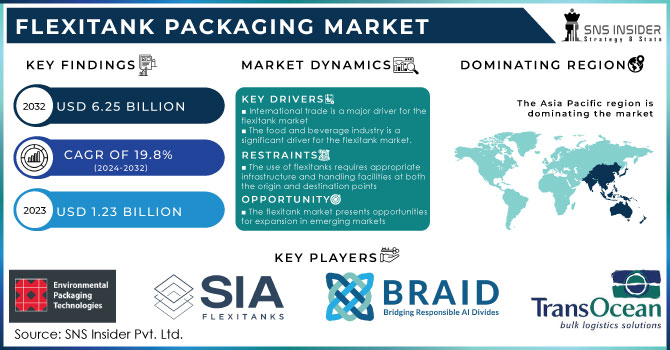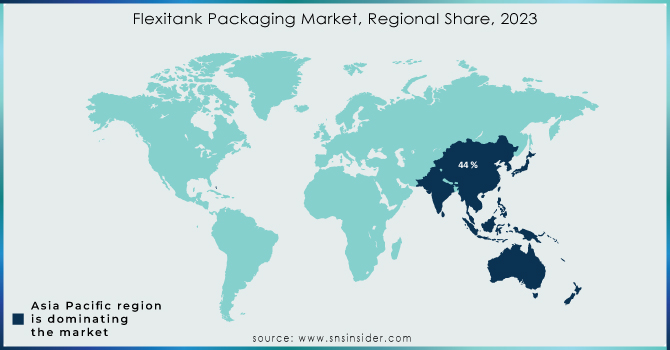Flexitank Packaging Market Key Insights:

Get more Information on Flexitank Packaging Market - Request Sample Report
The Flexitank Packaging Market size was valued at USD 1.23 billion in 2023 and is expected to Reach USD 6.25 billion by 2032 and grow at a CAGR of 19.8 % over the forecast period of 2024-2032.
Flexitanks have capacities ranging from 12,000 to 26,000 liters. These are frequently used to ship a wide variety of liquid goods.
The market for temperature-sensitive liquid transportation in single-trip flexitanks has grown significantly as a result of pharmaceutical companies' preference for these containers. Because Flexitanks are significantly less expensive than ISO containers and drums and can carry up to 20% more payload than IBCs and 45% more payload than drums, they are the most economically advantageous bulk packaging options. Additionally, the majority of their uses are single-use, which lowers the possibility of contamination.
The need to reduce bulk packaging weight in order to improve freight cost-effectiveness is anticipated to support market expansion. A few other factors that are likely to boost product demand over the forecast years include low labor and logistic costs associated with handling flexitanks, zero cleaning costs due to one-time use, and eco-friendliness.
The use of the product for the transportation of hazardous liquids may be reduced as a result of factors like leakage or breakage of the contents in flexitanks, however, limiting the growth. Additionally, manufacturers should expect difficulties due to changing costs of plastic resins, which are used as raw materials in the production of flexitanks.
MARKET DYNAMICS
KEY DRIVERS:
-
International trade is a major driver for the Flexitank market
The demand for efficient and affordable transportation options for bulk liquids and commodities is rising as global trade expands. The demand for flexitank services is driven by expanding trade volumes, particularly in sectors like food and beverage, chemicals, and pharmaceuticals.
-
The food and beverage industry is a significant driver for the flexitank market.
RESTRAIN:
-
The use of flexitanks requires appropriate infrastructure and handling facilities at both the origin and destination points
It's possible that some ports, terminals, or warehouses lack the infrastructure or equipment needed to handle flexitanks effectively. In such circumstances, flexitank services may not be widely used, which would limit their market potential.
OPPORTUNITY:
-
The flexitank market presents opportunities for expansion in emerging markets
The need for liquid bulk transportation solutions rises as urbanization and industrialization take place in developing economies. By forming alliances and growing their services to meet the expanding demands of these regions, flexitank providers can access these markets.
-
Offering value-added services beyond basic flexitank transportation can create opportunities for differentiation and revenue growth.
CHALLENGES:
-
Flexitanks have certain limitations when it comes to the types of liquids they can transport
Products with particular properties, such as corrosive chemicals, highly viscous substances, or temperature-sensitive goods, might not be appropriate for transportation in flexitanks. This makes it difficult for flexitank suppliers to satisfy a variety of customer demands because it restricts the use of flexitanks in some industries or limits the range of goods that can be transported.
IMPACT OF RUSSIA-UKRAINE WAR
For Bulk Distributor, the direct effects of the conflict on regional trade have largely been limited to the collapse of Ukraine's exports of sunflower oil and related goods. The largest producer and exporter of sunflower oil is Ukraine. Smaller shipments are frequently transported in flexitanks, but parcel tankers handle the bulk of the transport.
Supply lines and transportation routes between Russia and Ukraine could be affected by the conflict. Due to safety concerns and logistical difficulties, Flexitank shipments may experience delays, route changes, or even a total suspension. The availability and price of Flexitank services may be impacted by this disruption.
The Black Sea and Sea of Azov coasts are currently hazardous or impassable. There have been missile attacks on ships, ship arrests, and lane closures for commercial shipping. Odessa and Mariupol, two seaports in Ukraine, are shut down, damaged, or even being attacked. Transport of containers and goods has stopped, and cargo and equipment are stranded at ports.
IMPACT OF COVID-19
Logistics and cargo transportation in the U.S. Are struggling as a result of the COVID-19 crisis. The economy has been negatively impacted by safety measures to stop the disease's spread. In April 2020 GDP fell and the unemployment rate rose by 14 % in US.
Since more people are now making purchases online due to COVID-19, the e-commerce platform has quickly gained popularity. When the economy recovers, some of these transactions will probably return to in-person interactions, but studies show that e-commerce has the potential to expand further.
The COVID-19 pandemic caused disruptions in global supply chains due to lockdowns, travel restrictions, and reduced production. Flexitank shipments were affected as factories and manufacturing facilities faced closures or operated at limited capacities. This led to delays, order cancellations, and a decline in demand for Flexitank services.
KEY MARKET SEGMENTATION
By Product Type
-
Single-Trip
-
Multi-Trip
By Loading Type
-
Top Loading
-
Bottom Loading
By Application
-
Food Grade Liquids
-
Pharmaceutical Liquids
-
Industrial Products
-
Wine & Spirits
-
Others
REGIONAL ANALYSIS
Asia Pacific dominated the market and held a 44 % share of the global volume in 2023, due to the presence of China and India, the two biggest agricultural-producing countries. The expansion of the regional market was also aided by Indonesia and Malaysia's high levels of palm oil production and export. Due to the lower production costs in India and China, a number of important companies in Europe and North America have also outsourced production activities to these two nations. The demand for flexitanks is therefore expected to rise in the Asia Pacific region over the forecast period as a result of the potential growth of the food and pharmaceutical industries.
Over the course of the forecast, it is anticipated that the European market will expand significantly. In particular, in Germany, Switzerland, and the Netherlands, this can be attributed to the rise in the production and export of pharmaceuticals that are temperature-sensitive.
The steady growth of the US manufacturing sector, will cause North America to grow at a significant CAGR during the forecast period.

Get Customized Report as per Your Business Requirement - Enquiry Now
REGIONAL COVERAGE:
North America
-
USA
-
Canada
-
Mexico
Europe
-
Germany
-
UK
-
France
-
Italy
-
Spain
-
The Netherlands
-
Rest of Europe
Asia-Pacific
-
Japan
-
South Korea
-
China
-
India
-
Australia
-
Rest of Asia-Pacific
The Middle East & Africa
-
Israel
-
UAE
-
South Africa
-
Rest of the Middle East & Africa
Latin America
-
Brazil
-
Argentina
-
Rest of Latin American
Key Players
Some major key players in the Flexitank Packaging market are Environmental Packaging Technologies Inc, SIA FLEXITANKS, Mak & Williams Flexitank Supply Ltd, Braid Logistics UK Ltd, Yunjet Plastics Packaging, K Tank Supply Ltd, Trans Ocean Bulk Logistics Ltd, Büscherhoff Packaging Solutions GmbH, TRUST Flexitanks, Full-Pak, and other players.
RECENT DEVELOPMENTS
-
The Pulse Flexitank, a new Flexitank from Hillebrand, can agitate its contents for uniform viscosity.
| Report Attributes | Details |
| Market Size in 2023 | US$ 1.23 Bn |
| Market Size by 2032 | US$ 6.25 Bn |
| CAGR | CAGR of 19.8% From 2024 to 2032 |
| Base Year | 2023 |
| Forecast Period | 2024-2032 |
| Historical Data | 2020-2022 |
| Report Scope & Coverage | Market Size, Segments Analysis, Competitive Landscape, Regional Analysis, DROC & SWOT Analysis, Forecast Outlook |
| Key Segments | • By Product Type (Single-Trip, Multi-Trip) • By Loading Type (Top Loading, Bottom Loading) • By Application (Food Grade Liquids, Pharmaceutical Liquids, Industrial Products, Wine & Spirits, Others) |
| Regional Analysis/Coverage | North America (USA, Canada, Mexico), Europe (Germany, UK, France, Italy, Spain, Netherlands, Rest of Europe), Asia-Pacific (Japan, South Korea, China, India, Australia, Rest of Asia-Pacific), The Middle East & Africa (Israel, UAE, South Africa, Rest of Middle East & Africa), Latin America (Brazil, Argentina, Rest of Latin America) |
| Company Profiles | Environmental Packaging Technologies Inc, SIA FLEXITANKS, Mak & Williams Flexitank Supply Ltd, Braid Logistics UK Ltd, Yunjet Plastics Packaging, K Tank Supply Ltd, Trans Ocean Bulk Logistics Ltd, Büscherhoff Packaging Solutions GmbH, TRUST Flexitanks, Full-Pak |
| Key Drivers | • International trade is a major driver for the flexitank market • The food and beverage industry is a significant driver for the flexitank market. |
| Market Opportunities | • The flexitank market presents opportunities for expansion in emerging markets • Offering value-added services beyond basic flexitank transportation can create opportunities for differentiation and revenue growth. |

